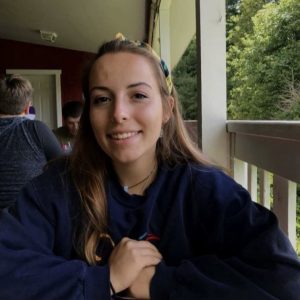This past week of training and working on Camp Pause and Gardens Speak has been both exciting and slightly overwhelming in the best way. I started off training for Gardens Speak, but had not realized how jarring it would be to see a piece- especially one I’ve been so thrilled to experience in real life- behind the scenes. Seeing how many people and elements go into the piece makes it more authentic and meaningful in a unique way. I have yet to experience Gardens Speak as an actual showing, but I am eager to see how it differentiates from merely training around it- the different lighting, smells, and feelings that I know I will experience because I was told just how it all happens.
The Camp Pause Training was significantly shorter and more tech-based, but it was also nice because it was the training where I got to see Tania El-Khoury again. It’s interesting to hear how objects in the piece, such as the colorful little chairs, are put there with a specific purpose, for more than just for sitting. The chairs and their coordinating cords were specifically made those colors, and invoke feelings of childhood. The type of chairs are children’s chairs in Palestine and Lebanon. All of which I wouldn’t have known and didn’t know until Tania explained it in training, which I thought was a lovely bonus. Art is always purposeful in what it does, says, and expresses. I felt similarly with the Gardens Speak training and learning that the dirt is sprayed with an earthy essential oil, and flowers are thrown onto the audience while they rest on the graves. These little aspects of the overall piece shape it and make it special.
I have worked both the Camp Pause and Gardens Speak pieces at this point and feel a sort of peculiar feeling watching audiences going into an exhibit and walking out. I feel that particularly with the Gardens Speak piece, there is an intimate, unspoken element of trust required from the artist and the audience. Trust that the audience will respect the piece, trust that they will not make it about themselves, and I feel that this trust is not necessarily always kept up on the audience’s part. Hearing audience members leave the Camp Pause piece, saying things like, “That made me so sad,” and “What a depressing video,” feels selfish and lacks the maturity to realize that as a viewer, you only experience something that is someone else’s entire life for 10 minutes, something which you don’t have to live with once you leave the exhibit space. I suppose that is the side effect of interactive pieces, because self-centered people will turn an interactive piece and make into how they feel about their own lives, their own political climates, when that’s not what these pieces are about. But the beauty of the pieces are their interactivity and the ability to turn an issue that feels remote- like the Syrian war or the Israel-Palestine conflict- and make it feel next door to a viewer, and personal. Humans empathize with other people when they feel like individuals rather than masses, and that’s why pieces like Camp Pause and Gardens are so important.

